Samsung Galaxy Note 4 vs Note 3: Is it worth the upgrade?
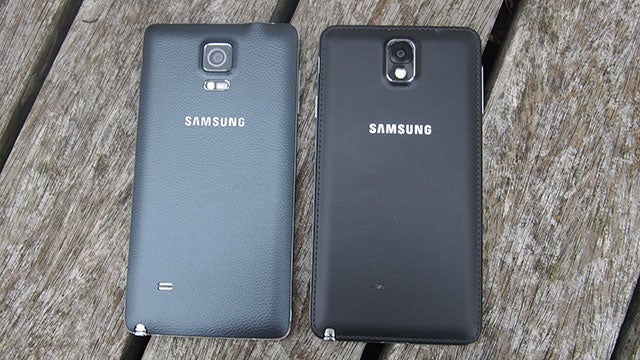
Should you buy the Note 4 or stick with the Note 3? We’ve lived with both and here’s our verdict on Samsung’s phablets
Samsung’s phablet has paved the way for oversized phones to become the norm. Now the likes of the Xperia Z3, the HTC One M9 and even the iPhone 6 Plus have proved that big is the way forward.
The Galaxy Note 4 (which has since ben updated with the Note 5) is in a league of its own and one of the best smartphones we’ve used recently. But how does it compare to the previous model, the Samsung Galaxy Note 3? We thought last year’s version was great, if not quite perfect.
Has Samsung finally perfected the design in the Galaxy Note 4? Spending time with both handsets, here’s why we think you’ll consider making the upgrade.
Watch our Samsung Galaxy Note 4 video review
Related: iPhone 6 vs Samsung Galaxy S6 in-depth comparison
Samsung Galaxy Note 4 vs Note 3: Design
Samsung Galaxy Note 4: Plastic, Metal trim, removable back, 176g, 8.5mm thick
Samsung Galaxy Note 3: Plastic, Leather effect removable back, 168g, 8.3mm thick
The most common criticism of Samsung phones is that they often don’t look or feel all that expensive. The company is trying to address this with phones such as the Samsung Galaxy Alpha and the new Note 4. Thankfully, it shows.
There’s still the leather-effect plastic back, but rather than having naff chromed plastic running around the sides, the Note 4 use real metal. It’s a cool anodised aluminum finish that’s a darker shade than the one found on the Alpha.
Samsung’s also managed to slim down the bezel even further this year. There’s hardly any bezel on the Galaxy Note 4 at all, making it ever so slightly narrower than the Note 3. This makes it a little easier to handle, and the gently curved back also makes it fit more snugly for one-handed operation.
The texture on the back has been changed a little, too. While still essentially based on the texture of leather, it’s a bit less of an obvious copy this time. The cartoonish stitching of the Note 3, which is actually just a pattern embossed into the plastic, has been binned in favour of something a bit lower-key, a bit classier.
The silhouette of the phone is also a tiny bit different, with a boxier design. Samsung’s gradually sharpened up the Note series’ curves since it began in 2011, presumably in an attempt to shave off some excess fat.
As ever, the Note 4’s S Pen stylus slots into the bottom of the phone. The changes Samsung’s made are all positive ones, and for that reason the new Note wins on the design front.
Related: Note 5 vs Note 4: What’s new?
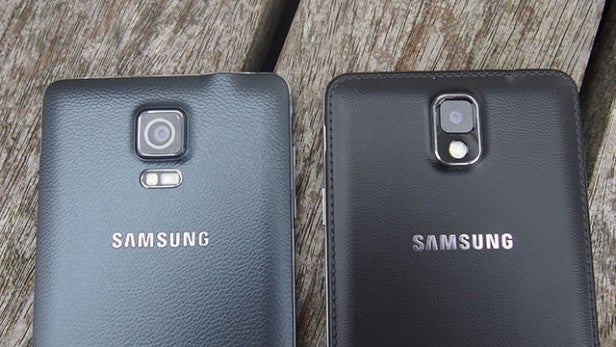
Samsung Galaxy Note 4 vs Note 3: Hardware extras
Samsung Galaxy Note 4: Heart-rate sensor and fingerprint scanner
Samsung Galaxy Note 3: More conventional IR transmitter and NFC
The S Pen is, to a large extent, what the Note series is all about. However, the Samsung Galaxy Note 4 also benefits from a few other bells and whistles that hadn’t yet been made ‘standard’ across top Samsung phones last year when the Note 3 came out.
We’re talking about the fingerprint scanner and heart-rate sensor. Both were introduced in the Samsung Galaxy S5, and both are found in the Galaxy Note 4, the Galaxy S6, S6 Edge but not the Note 3.
The fingerprint scanner sits underneath the Home button under the screen, and can be used to unlock the phone and authorise PayPal payments. It’s a neat extra, especially as something to show off to iPhone 6-owning friends who brag about their Touch ID sensors. Can you live without it? We’d say yes.
However, we really don’t think it’s one of the Note 4’s more important changes. As you have to glide your finger over the centre of it rather than just holding a digit there, it doesn’t always work, especially when you’re trying to do it quickly.
The heart-rate sensor on the back is less problematic, but it’s also less remarkable. Using S Health you can track your heart rate on the Note 4, but you can monitor your heart rate pretty easily with just about any phone as long as it has a rear camera and an LED flash near the lens. Aside from those hardware requirements, all you need is a heart-rate app – there are free ones on Google Play.
There’s new stuff, certainly. But these little extras don’t merit upgrading from the Note 3 to the Note 4, in our opinion.
Both phones have most extras you might see in other high-end, feature-packed phones, such as an IR transmitter and NFC.
Related: iPhone 6 Plus vs Note 4: Battle of the big phones
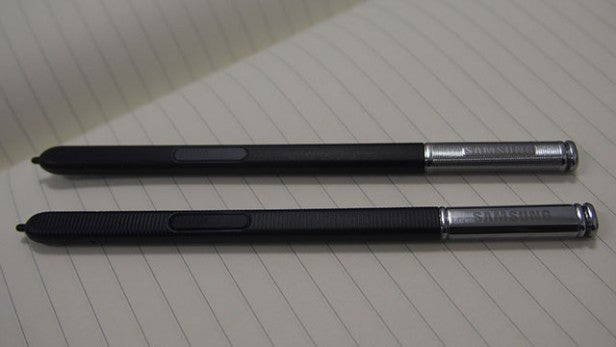
Note 3 S-Pen (top) and Note 4 S-Pen (bottom)
Samsung Galaxy Note 4 vs Note 3: S Pen
Samsung Galaxy Note 4: 2048 dps pressure sensitivity
Samsung Galaxy Note 3: 1024 dps pressure sensitivity
If hardware extras are what you’re after, the Note series’ S Pen is where it’s at. While there are some new software features this time around, the core hardware that makes the Note 4’s S Pen stylus possible is similar to the Note 3’s.
Both styli use a digitiser layer in the screen that enables the use of a pressure-sensitive accessory that doesn’t need its own power source. And the result is something special.
Although not widely publicised, the S Pen technology is powered by Wacom, the company that makes the most popular professional-grade graphics tablets. As well as being pressure-sensitive, this technology means the Note 3 and Note 4 can sense the presence of the pen before it even touches the screen.
The new software tweaks within the Note 4 focus on opening up the creative potential of the S Pen stylus and making it easier to use. This includes the ability to select copy in web pages when previously you had to go through the more fussy process of cutting it out. Sensitivity has also been massively increased this time around, with the Note 4 able to sense 2048 levels of pressure to the Note 3’s 1024. It’s real high-end hardware.
Writing and drawing is more fluid, making this still one of the best styli bundled with a tablet, perhaps only rivalled by the one supplied with the Nvidia Shield tablet.
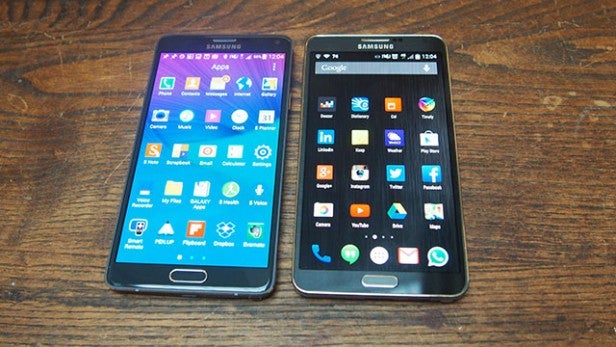
Samsung Galaxy Note 4 vs Note 3: Screen
Samsung Galaxy Note 4: 5.7-inch 2560 x 1600-pixel Super AMOLED
Samsung Galaxy Note 3: 5.7-inch 1920 x 1080-pixel Super AMOLED
The Samsung Galaxy Note 4 has quite a remarkable screen. It’s the first QHD Super AMOLED phone display and is a big step up from the Note 3’s Full HD display.
This provides the same sort of ridiculously high pixel density you get in something like the LG G3, but with the additional benefits of a Super AMOLED panel. Pixel density is much, much higher than the Note 3, which uses a slightly more conventional 5.7-inch 1080p Super AMOLED screen.
So, both displays are the same size, but the Galaxy Note 4’s is a lot sharper – with a whopping 515ppi pixel density. There’s some question as to whether this extra sharpness really makes all that much difference, as the 386ppi Note 3 is still very sharp, but the more discerning among you will be able to spot the upgrade.
What really makes a good impression is the same colour accuracy that Samsung introduced in the Galaxy S5. Use the Cinema or Photo modes in the latest Samsung phones and you’ll get really wonderful colour reproduction.
If you want one of the best screens there is on a phone, then the Note 4 is the winner here.
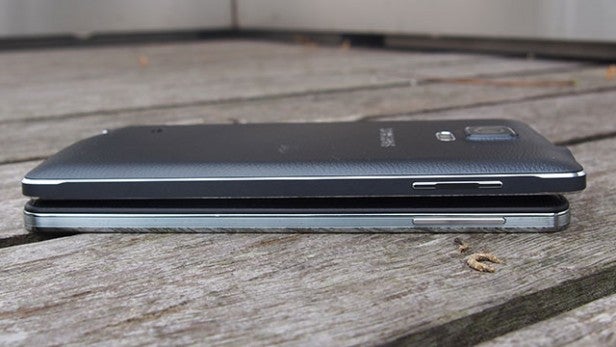
Samsung Galaxy Note 4 vs Note 3: CPU and Power
Samsung Galaxy Note 4: Exynos 5433 or Snapdragon 805
Samsung Galaxy Note 3: Exynos Octa 5420 or Snapdragon 800
With the top Samsung phones, assessing power isn’t always just a case of looking at one CPU. Both the Note 3 and Note 4 come in different variations that use Qualcomm Snapdragon processors and Samsung’s own Exynos ones.
Last year, we much preferred the Snapdragon 800 version of the Note 3 to the Exynos 5420 one. The Exynos sounded more exciting, as it has eight cores rather than four, but as the Note 3 can only use four at once, you don’t really get octa-core power. The design is really more about efficiency.
This year, the situation is a little different. The Snapdragon 805 version of the Note 4 uses a 32-bit CPU, but the Exynos 5420 is a true 64-bit processor. We’re actually slightly disappointed to see the Note 4 use a 32-bit CPU when the 64-bit future is on the horizon. It really matters because Android 5.0 Lollipop will soon bring full support for 64-bit processors.
But how do the two generations of Snapdragon and Exynos chipsets compare?
The Snapdragon 805 is not a huge step up from the 801 of the Galaxy S5 or the 800 of the Note 3. They use the same Krait-based architecture, and each is basically a turbocharged version of its predecessor. You get more power, but technically they’re fairly similar.
Related: Samsung Galaxy S5 vs Note 4
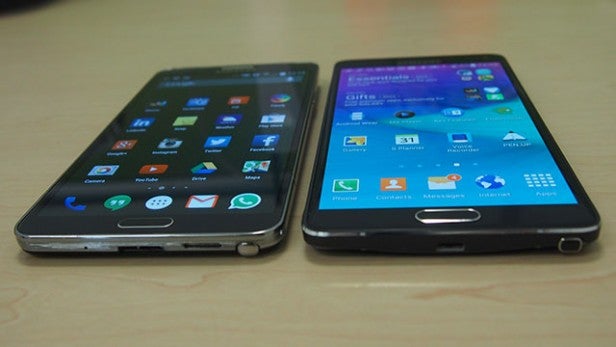
The Note 3’s Snapdragon 800 is a 2.3GHz processor, while the Note 4’s 805 a 2.7GHz one. However, it’s in the GPU that we see the real performance boost.
The Adreno 420 of the Note 4 is about 40 per cent more powerful than the Adreno 330 of the Note 3. It’s this that’ll make the new phone capable of handling high-end 3D games at native 2560 x 1600-pixel resolution without dropping any effects.
So what about the Exynos 5433? We could easily call this what the Exynos octa-core processor should always have been. Unlike the Note 3’s Exynos 5420, all eight cores can be used at once, and it’s a real 64-bit processor. It’s the future, in other words.
Having a 64-bit processor also means the Note 4’s 4GB of RAM makes a good deal more sense. In a 32-bit system, the amount of memory that can be addressed at once is limited to 4GB, meaning that having any more than 4GB is pointless, and even the whole 4GB generally won’t be able to be used.
There’s no such limit with a 64-bit system, where the addressable memory space is so vast that it doesn’t bear thinking about in mobile terms.
Both phones are well equipped in the power department, so you should have no problem with more intensive multitasking operations.
Samsung Galaxy Note 4 vs Note 3: Software
Samsung Galaxy Note 4: Android 4.4 KitKat with TouchWiz UI
Samsung Galaxy Note 3: Android 4.3 JellyBean with TouchWiz UI
Like all of Samsung’s top-end phones, the Note 4 will use a version of the custom Samsung Android UI. However, the Note 4’s is a generation on from the Note 3’s.
It benefits from the improvements made in the revamped version of the TouchWiz UI seen in the Galaxy S5. That means a bit less bloat, some simpler visual style points and the new settings menu. It’s a bit overblown, with its simplification backfiring on occasion, but it’s not bad. And generally it looks better than the Note 3’s interface.
The good news is that along with stripping back the bloatware, some of the more gimmicky settings have been left out of the Note 4. The underwhelming Magazine UX has gone, too, replaced with a new Flipboard-powered widget.
Arguably the Note’s best software feature is MultiWindow, and it’s even better on the Note 4. The Samsung phone’s big screen is ideal for running multiple apps at the same time, and now you have the added bonus of being able to run pop-up windows that you can move around the screen.
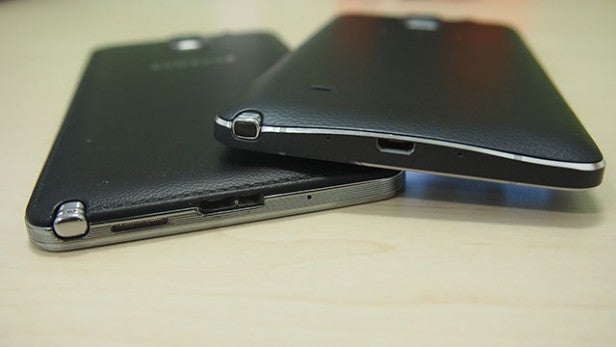
Samsung Galaxy Note 4 vs Note 3: Camera
Samsung Galaxy Note 4: 16-megapixel Sony sensor with OIS, LED flash
Samsung Galaxy Note 3: 13-megapixel sensor, LED flash
Last year, we found that the Note 3 had a slightly worse, but essentially similar, camera to the Galaxy S4. This year, the Note 4 may even have a slightly better camera than the Galaxy S5.
The Note 3 has a 13-megapixel main sensor and the Note 4 a 16-megapixel sensor, both made by Sony. The Galaxy S5 has a Samsung-made ISOCELL sensor that we wish had made its way into the Note 4, because it’s fantastic.
Samsung’s previous camera sensors haven’t been much to brag about, but the 16-megapixel ISOCELL sensor in the Galaxy S5 is pretty special. The Note 4’s sensor is a bit more conventional, but it’s still a lot better than the Note 3’s.

Samsung Galaxy Note 3 photo sample

Samsung Galaxy Note 4 photo sample
With OIS on-board this is one of the best all-round cameras we’ve used. Optical Image Stabilisation means you’ll experience less hand-shake blur when using slower shutter speeds in low light, which in turn means more light will get to the pixels. The Note 4 also offers an improved front-mounted selfie camera, with a 3.7-megapixel sensor to the Note 3’s 2-megapixel one.
It builds on the S5’s shooting functionality, making it one of the best all-round smartphone cameras we’ve used. Whether it’s close-up macro-style images or from a distance, the Note 4 delivers greater detail, improved sharpness and generally more vibrant image quality compared to the Note 3.
HDR mode is one of Samsung’s strengths and it really impresses on the new Samsung phablet. While low-light shooting isn’t entirely free from some image noise, OIS does manage to produce brighter, more detailed images when shooting conditions are more challenging.
Like the S5 and the Note 3 you can shoot video at up to 4K resolution, although you have to sacrifice some of the more useful camera modes such as Dual Camera and HDR. That’s not a big issue here, as Full HD 1080p footage is still strong and the addition of optical video stabilisation is another reason you’ll get better results from the new Note.
Verdict
If we’re honest, we were a tiny bit disappointed with the Note 3 when it arrived. It just wasn’t quite the upgrade over the Note 2 that we were hoping for.
With the Note 4 it’s an entirely different story. There’s the design improvements, a better camera and the screen is a massive upgrade from the Note 3. If you’re buying the Note 4 for the S Pen, the software that makes best use of it isn’t radically different, but it’s a more fluid and accurate experience.
The Note 4 is still one of the priciest big phones to buy, but if you are sold on the Galaxy Note vision, then it’s a no-brainer to make the upgrade. Especially if you live in the UK and want a Note 5.


